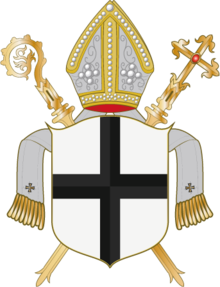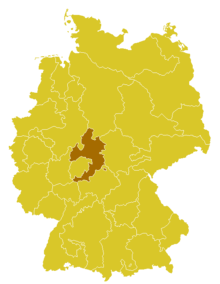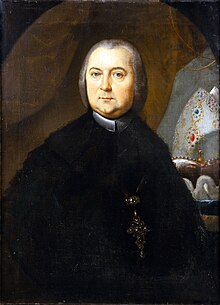
Boniface, OSB was an English Benedictine monk and leading figure in the Anglo-Saxon mission to the Germanic parts of Francia during the eighth century. He organised significant foundations of the church in Germany and was made bishop of Mainz by Pope Gregory III. He was martyred in Frisia in 754, along with 52 others, and his remains were returned to Fulda, where they rest in a sarcophagus which remains a site of Christian pilgrimage.

Fulda is a city in Hesse, Germany; it is located on the river Fulda and is the administrative seat of the Fulda district (Kreis). In 1990, the city hosted the 30th Hessentag state festival.

Rabanus Maurus Magnentius, also known as Hrabanus or Rhabanus, was a Frankish Benedictine monk, theologian, poet, encyclopedist and military writer who became archbishop of Mainz in East Francia. He was the author of the encyclopaedia De rerum naturis. He also wrote treatises on education and grammar and commentaries on the Bible. He was one of the most prominent teachers and writers of the Carolingian age, and was called "Praeceptor Germaniae", or "the teacher of Germany". In the most recent edition of the Roman Martyrology, his feast is given as 4 February and he is qualified as a Saint ('sanctus').

The Diocese of Mainz, historically known in English as Mentz as well as by its French name Mayence, is a Latin Church ecclesiastical territory or diocese of the Catholic Church in Germany. It was founded in 304, promoted in 780 to Metropolitan Archbishopric of Mainz and demoted back in 1802 to bishopric. The diocese is suffragan diocese in the ecclesiastical province of the metropolitan Archdiocese of Freiburg. Its district is located in the states of Rhineland-Palatinate and Hesse. The seat of the diocese is in Mainz at the Cathedral dedicated to Saints Martin and Stephen.

The Diocese of Eichstätt is a Latin Church diocese of the Catholic Church in Bavaria. Its seat is Eichstätt, and it is subordinate to the archbishop of Bamberg. The diocese was erected in 745; from the Middle Ages until 1805, it was a state of the Holy Roman Empire. The current bishop of Eichstätt is Dr. Gregor Maria Hanke, OSB; formerly the Abbot of the Benedictine Abbey of Plankstetten, he was named to the See by Pope Benedict XVI on 14 October 2006, and he was consecrated at the Cathedral of Eichstätt on 2 December 2006. The diocese covers an area of 6,025 km², with 48,9% just under half of the population is catholic.

The Archdiocese of Paderborn is a Latin Church archdiocese of the Catholic Church in Germany; its seat is Paderborn. It was a diocese from its foundation in 799 until 1802, and again from 1821 until 1930. In 1930, it was promoted to an archdiocese. From 1281 until 1802, the Bishopric of Paderborn was also a state of the Holy Roman Empire.
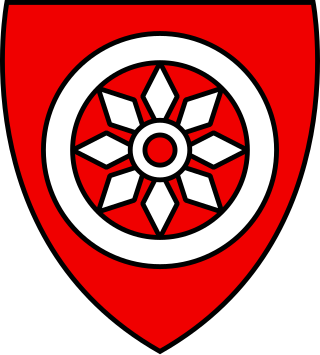
The Elector of Mainz was one of the seven Prince-electors of the Holy Roman Empire. As both the Archbishop of Mainz and the ruling prince of the Electorate of Mainz, the Elector of Mainz held a powerful position during the Middle Ages. The Archbishop-Elector was president of the electoral college, archchancellor of the empire, and the Primate of Germany as the papal legate north of the Alps, until the dissolution of the empire in 1806.

Hersfeld Abbey was an important Benedictine imperial abbey in the town of Bad Hersfeld in Hesse, Germany, at the confluence of the rivers Geisa, Haune and Fulda. The ruins are now a medieval festival venue.
Haymo was a German Benedictine monk who served as bishop of Halberstadt, and was a noted author.
The German Bishops' Conference is the episcopal conference of the bishops of the Roman Catholic dioceses in Germany. Members include diocesan bishops, coadjutors, auxiliary bishops, and diocesan administrators.
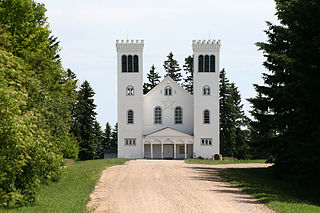
St. Peter's Abbey is in Muenster, Saskatchewan, Canada. It is the oldest Benedictine monastery in Canada. It was founded in 1903.
Siegfried I was the Abbot of Fulda from 25 December 1058 until 6 January 1060, and from January 1060 until his death in February 1084, he was Archbishop of Mainz.

The Archdiocese of Salzburg is a Latin Church archdiocese of the Catholic Church in Austria. The archdiocese is one of two Austrian archdioceses, serving alongside the Archdiocese of Vienna.
Eigil was the fourth abbot of Fulda. He was the nephew and biographer of the abbey's founder and first abbot Saint Sturm. We know about Eigil primarily from the Latin Life that the monk and teacher of Fulda, Candidus Bruun composed about him after his death.

The Abbey of Fulda, from 1221 the Princely Abbey of Fulda and from 1752 the Prince-Bishopric of Fulda, was a Benedictine abbey and ecclesiastical principality centered on Fulda, in the present-day German state of Hesse.
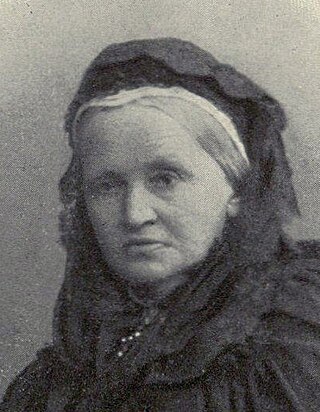
Julie von Massow was a Prussian woman who started a movement, Ut Omnes Unum, "that all may be one", which promoted reconciliation between the Christian churches, a policy known as reunionism.

Fulda Cathedral is the former abbey church of Fulda Abbey and the burial place of Saint Boniface. Since 1752 it has also been the cathedral of the Diocese of Fulda, of which the Prince-Abbots of Fulda were created bishops. The abbey was dissolved in 1802 but the diocese and its cathedral have continued. The dedication is to Christ the Saviour. The cathedral constitutes the high point of the Baroque district of Fulda, and is a symbol of the town.
Johann Adam Rieger was a bishop of the Roman Catholic Diocese of Fulda from 1812 to 1831.
Sturm, also called Sturmius or Sturmi, was a disciple of Boniface and founder and first abbot of the Benedictine monastery and abbey of Fulda in 742 or 744. Sturm's tenure as abbot lasted from 747 until 779.
Ermanrich or Ermenrich was a Benedictine monk and court chaplain, who became Bishop of Passau from 866 to 874. He supported East Francia's expansion to the east, and likewise the expansion of the eastern bishoprics, and opposed the missionary efforts of Cyril and Methodius, who he considered intruders. This brought him into conflict with the Papacy, which supported the brother missionaries.

